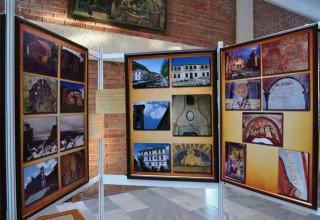The Regional Historical Museum - Blagoevgrad is a cultural, scientific and educational institution with more than half a century of history. Since its inception in 1952, the museum has vigorously pursued its mission of preserving, studying and promoting the millennial history and the everlasting beauty of the Pirin region. Located in the Varosha quarter, near the church "Vavedenie Bogorodichno" and together with them is the object of the National Movement "Know Bulgaria - 100 national tourist sites".
The exhibition area of RHM-Blagoevgrad is spread on four levels and shows the natural wealth, the archaeological, historical and ethnographic heritage of the Blagoevgrad region, as well as the struggles for educational, ecclesiastical and political independence of the Bulgarian population in the region. Biodiversity in the Pirin region is represented by scientific collections of rocks and minerals, protected and rare examples of nature - endemic plants, vertebrates and invertebrates. An important part of the exhibition is dedicated to the material and spiritual culture of Neolithic and Chalcolithic: Neolithic collections of clay vessels with white-painted ceramics; cult clay figures, mostly feminine; seals and cult objects of clay - altars, thrones, models of houses.
The materials of the Thracian age - the clay Megara cup and the armament of a Thracian warrior from the end of the 4th - the beginning of the 3rd century BC - are of exceptional value; a collection of exquisite clay lamps; graceful terracotta feminine and animal figures; tombstones and votive marble slabs; medical instruments; colored clay masks of Bacchantes and Satyrs.
The exposition, presenting the history of the Bulgarian Middle Ages, focuses on two major collections: Early Bulgarian jewelry from the X-XI century, unique in their work with the combination of Slavic, Proto-Bulgarian and antique local crafts traditions; A large collection of picturesque artistic ceramics in the sgraffito technique of the XI century (Melnik), as well as an invaluable relic from the middle of the 18th century - a Russian old-style liturgical book - Gospel, printed in Moscow.
The museum preserves outstanding cultural values from the period of the Bulgarian revival, among which special place is: the first printed edition of “Istoria Slavyanobulgarska” from 1844; “Nedelnik” of Sophronii Vrachanski from 1868; valuable documentary material, including 24 letters from Gotse Delchev; personal belongings and documents of the fighters of the national liberation movement.
The magic of Bulgarian folk art reflects in the rich ethnographic treasury of the museum - collections of fabrics, costumes, ceramics, metal and wood from the end of the 19th and the beginning of the 19th century. In the 20th century. The collections of paintings by Zlatyu Boyadzhiev, drawings by Vladimir Dimitrov-Maistora, paintings of Stoyan Sotirov stand out among the priceless wealth of the museum fund. In 1976 the exhibition "Birthplace of Georgi Izmirliev - Makedoncheto" was opened with an interior and historical-administrative part next to the church "Vavedenie Bogorodichno". The museum displays its significant fund of cultural values through temporary exhibitions tailored to European cultural patterns of communication.
Availability for visits: Paid, all year round
Transport accessibility: at the Centre of Blagoevgrad, near road
Tourist infrastructure: hotels, restaurants, shops









